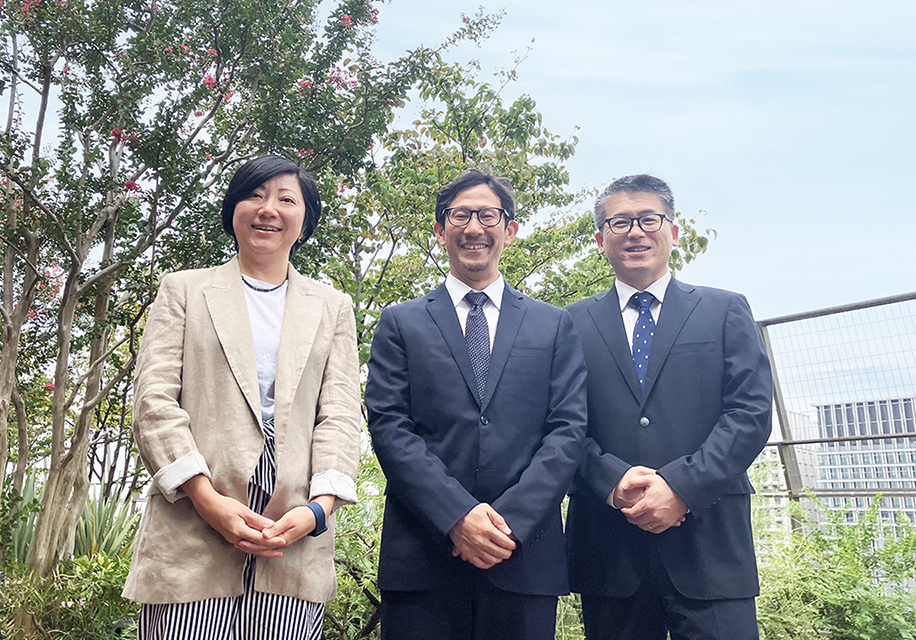Being a Pioneer in an Uncertain Future
How should we move toward achieving net-zero emissions by 2050?
To achieve this goal in an uncertain future, the NYK Group needs leaders who will show the way forward. In April 2023, the Decarbonization Group was established within the ESG Strategy Headquarters to serve as a control tower that will guide the Group's progress toward decarbonization.
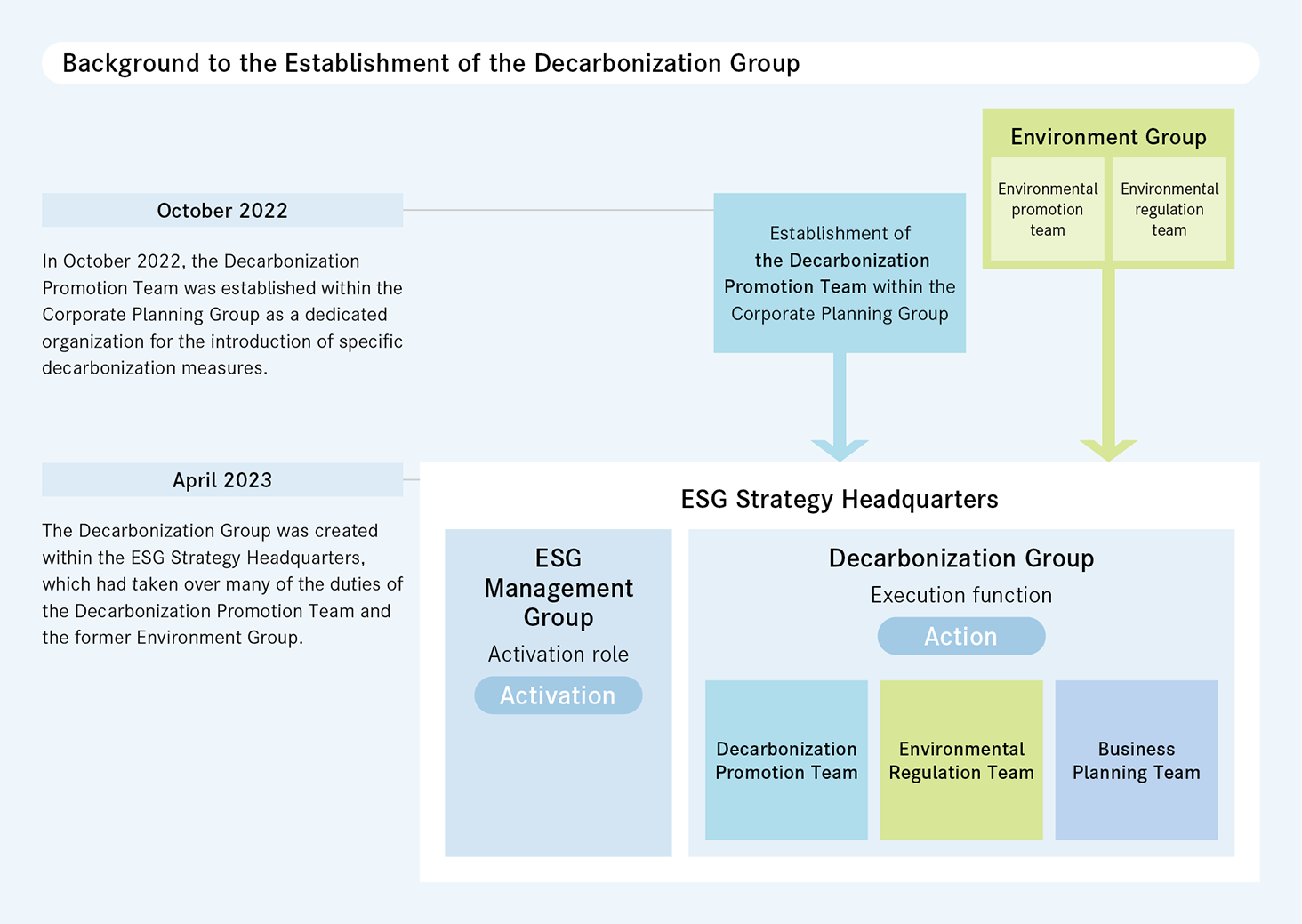
In October 2022, the Decarbonization Promotion Team was established within the Planning Group. Most of the functions of the Decarbonization Promotion Team and the former Environment Group were merged to form the Decarbonization Group.
Miwa Udagawa, who was a member of the former Environment Group, explains the reorganization.
“The former Environment Group had an advisory role within the NYK Group. I feel that this organizational change is very significant in that our position has moved to the implementation side in preparation for full-fledged Groupwide decarbonization efforts.”
Within the newly created ESG Strategy Headquarters, the Decarbonization Group is responsible for ensuring implementation.
Jun Kato, the manager of the Decarbonization Promotion Team, stresses the long-term nature of initiatives.
“The timeline of decarbonization initiatives is very long. Such initiatives cannot be finished today or tomorrow: they must continue for the next 10, 20, or 30 years. Our initiatives are like a journey that is continued by each successive generation.”
As the world faces the possibility of a shift in thinking about how to deal with climate change, decarbonization efforts based on a long timeline will steadily heighten the sustainability of the NYK Group and its future corporate value.
This undertaking cannot be achieved by the Decarbonization Group alone. Groupwide efforts based on a shared determination and goals will bring us closer to achieving decarbonization. The capabilities and change in the mindset of each employee will gradually create a large wave of change. Kato, who aims to instill the decarbonization concept among all employees, is steadfast in his determination.
“Precisely because the road ahead is long and uncertain, our mission is to establish a direction that clearly indicates how we should move forward.”
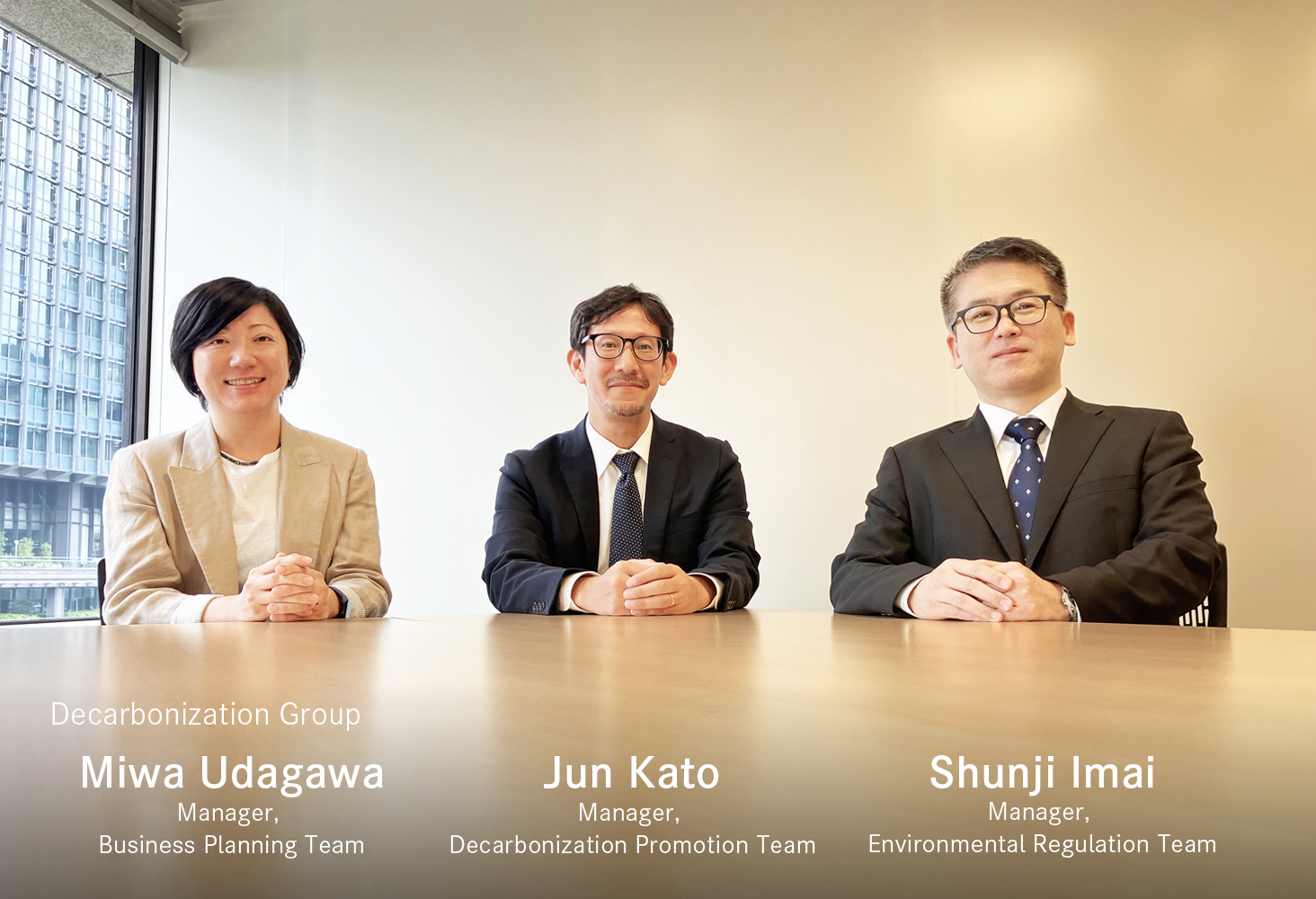
Focused on Decarbonization Leadership
The Decarbonization Group comprises three teams: the Decarbonization Promotion Team, the Business Planning Team, and the Environmental Regulation Team. The teams work together on a daily basis to achieve a single target: the establishment of awareness of decarbonization throughout the NYK Group.
Each team has focused efforts on establishing a commitment to decarbonization throughout the Group. The Business Planning Team keeps abreast of fast-moving European regulatory trends. It provides measures and support to ensure that operations comply with regulations. The Environmental Regulation Team, which participates in international rulemaking, incorporates the technical aspects of regulatory compliance into frontline operations. The Decarbonization Promotion Team, meanwhile, develops and leads the NYK Group’s decarbonization strategy, which requires the team to hold numerous in-house information exchange meetings and training sessions.
The number of participants in in-house study sessions held by Kato and Imai, who is the leader of the Environmental Regulation Team, has quadrupled over the past few years. Udagawa explains her sense of mission.
“With demand growing for sustainability disclosure, we have to effort decarbonization with more earnestness than the “doing it somehow” approach. For this reason, I am very conscious of the importance of incorporating sustainability activity into the day-to-day frontline operations of business entities.
She has a tangible sense of the growing interest in decarbonization efforts within the head office.
“Aggregation of monthly GHG data is really hard work, so the workload of each department has definitely increased. Everyone thinks it's hard work, but no one says, ‘I can't do it.’ This is proof that employees are beginning to understand that aggregation is an indispensable part of their duties. I feel that over the past six months or so, a favorable cycle of ‘awareness’ has begun.”
Being at the forefront of decarbonization efforts gives the three leaders unique access to information as well as insight into a range of values. Members of the Decarbonization Group share the insight they attain with the entire NYK Group. On occasion, they raise the vantage point of Group employees to the same height as that of members of the Decarbonization Group. In this way, the leaders give employees a real sense that they too should embark upon the journey toward decarbonization. Entrenching this sense of “awareness” was the first task that the leaders of the NYK Group’s decarbonization efforts wanted to accomplish.
Goals Everyone Can See
In November 2023, NYK issued the NYK Group Decarbonization Story.
Kato describes the story’s target audience.
“The readers of this story are Group employees.”
Is the NYK Group’s decarbonization strategy reaching overseas Group employees around the world? Has it been instilled in all of them? The three leaders recognize that different yardsticks are used by the head office, where the Decarbonization Group is based, and frontline operations.
Imai, who worked at sea for more than 10 years as a marine engineer, elaborates.
“The yardsticks of frontline personnel are safety and business. If environmental regulations are suddenly introduced, the speeds of ships are limited. As a result, ships are no longer able to operate as they used to. Regulations could even make business impossible.”
Ship operations entail a series of decisions. These decisions must not bring about the collapse of the world’s infrastructure. Nonetheless, environmental action is needed, as Kato explains.
“If we do not make decisions based on an understanding of the need for GHG emissions reductions, we will soon be in a world where we can no longer compete.”
Beyond the destination of ships lies a future that we must continue to anticipate. The NYK Group Decarbonization Story was produced as a way of uniting economic yardsticks and ESG yardsticks.
The Decarbonization Group’s role is to connect the entire NYK Group. Therefore, rather than individual business strategies, the Decarbonization Group must set forth concepts that will provide the basis for the Groupwide advancement of decarbonization.
How can decarbonization initiatives lead to the NYK Group’s corporate growth? Obviously, NYK Group employees implement businesses and projects. Setting out an unshakable concept that determines the direction in which employees should proceed in the course of business was no easy task. However, unless the corporate growth strategy and the decarbonization initiatives are combined into a single narrative, focusing on a single direction is challenging for huge organizations.
Kato, who spearheaded the production of the NYK Group Decarbonization Story, recalls the long period spent on linking corporate growth and decarbonization strategies.
“It is not difficult if all you want to do is present your initiatives. However, we are spending a lot of money on a very uncertain initiative called decarbonization. I think some employees are concerned about investing so much money in decarbonization. This is why we have to show where we are going and how we will move forward. Employees must be able to see that decarbonization is likely to produce corporate growth. Understanding this will convince them that decarbonization is necessary and that it must be pursued proactively.”
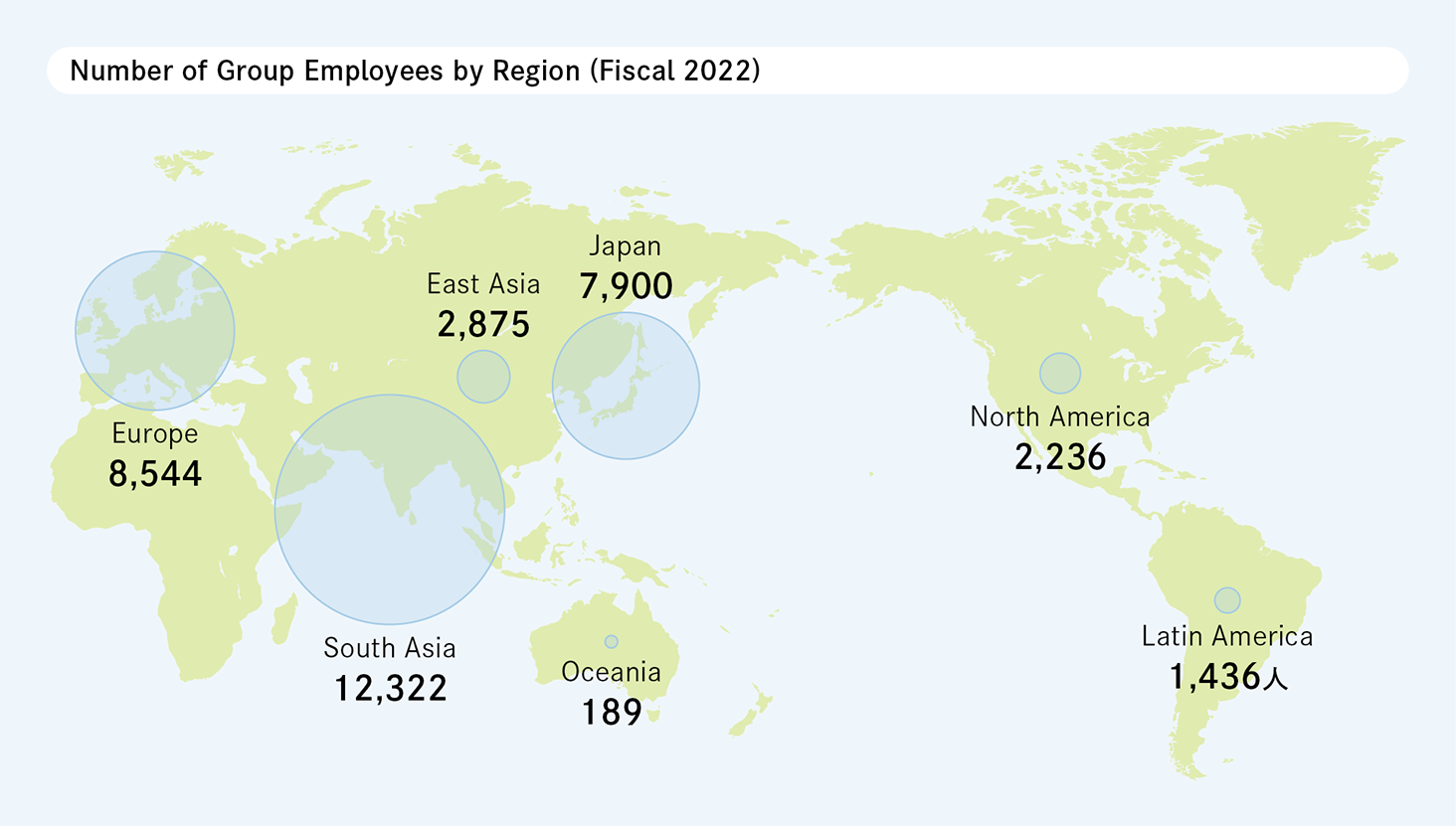
Commitment Expressed by Increasing Our Fiscal 2030 Reduction Target by 15%
Becoming net zero by 2050 is a long-term target premised on future technological innovation. On the other hand, the reduction in GHG emissions from shipping of at least 30% by fiscal 2030, which was announced in the medium-term management plan, is a figure that we aim to achieve by using the technologies available today. Even after considering the economic impact, the feasibility of achieving this figure is assured.
In the NYK Group Decarbonization Story, the abovementioned fiscal 2030 target has been updated to a 45% reduction.
This 45% figure is a reduction percentage in line with the 1.5℃ scenario of the Paris Agreement, which was adopted by the 21st Conference of the Parties to the United Nations Framework Convention on Climate Change (COP21) in 2015 and entered into force in the following year.
With the aim of minimizing climate disasters and impacts on organisms, the 1.5℃ scenario limits the temperature rise by the end of the 21st century to 1.5℃ above pre-industrial levels. In the maritime shipping industry, few companies have set out reduction percentages in line with the 1.5℃ scenario. Kato explains that the NYK Group’s target is ambitious.
“Among those who have made declarations of net zero by 2050, almost none have set medium-term numerical targets for 2030. By contrast, we have set ourselves just such a target.”
One of the aims of setting this ambitious target is to encourage the NYK Group and its stakeholders to jointly pursue technological innovation for 2050. For Kato, however, the numerical target has even greater significance.
“To achieve the 1.5℃ goal, humanity must not emit GHG into the atmosphere beyond a fixed upper limit. Much of the world is now striving to achieve the 1.5℃ goal. In this context, I believe that emissions reductions based on the previous 2℃ goal are no longer enough. We have to adopt an aggressive stance.”
The target has not simply been established for the sake of setting an “ambitious goal.” In setting the target, the management team was consulted. Also, specific actions and milestones with target reduction percentages have been established for a series of stages through until 2030. With a view to realizing the target, the Decarbonization Group will carefully examine actual circumstances.
By acting based on a high vantage point, the strength that the NYK Group is cultivating now will one day become its competitive advantage. In time, as more and more people share the same goals, regulations will follow. As well as contributing to the sustainability of the NYK Group, the 45% figure set by the Decarbonization Group will spur decarbonization in the maritime shipping industry as a whole.
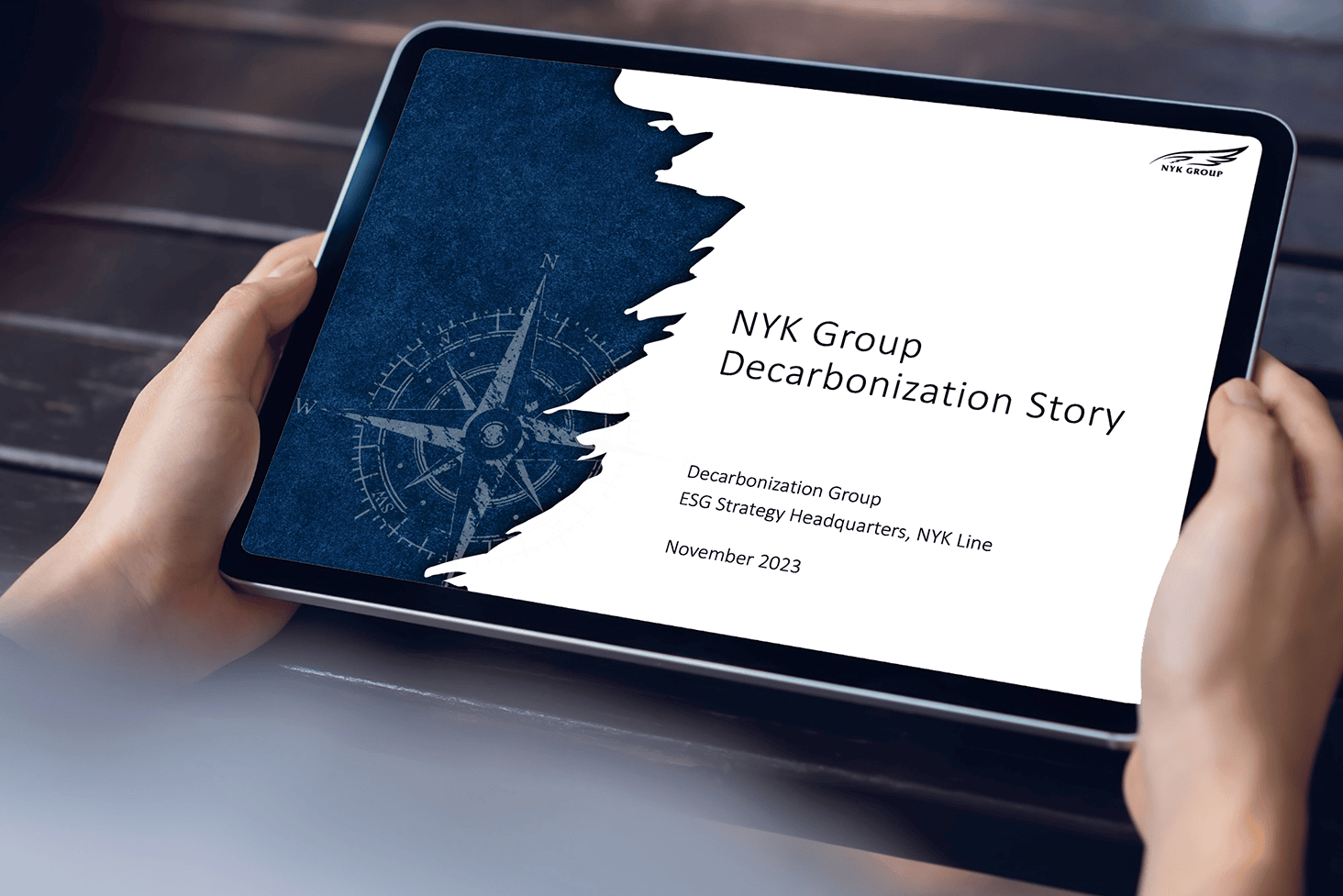
Our Current Focus and What We Hope to See Someday
Decarbonization is a goal that must be achieved not only by the NYK Group but also by the entire world. That is why the Decarbonization Group, which is tasked with supporting both the NYK Group’s sustainable growth and the resolution of social issues, bears such a heavy responsibility. What is the source of the motivation that enables the members of the Decarbonization Group to continue decisively moving forward on such a path?
Imai recalls a major shock that inspired him.
“I actually spent more than 10 years working on board ships. When I calculated the fuel consumption of the ship I was on, I realized that it had emitted one million tons of CO₂.”
Udagawa, who has two children, says she is inspired on a daily basis by the new generation’s high level of ESG literacy.
“When I see CO₂ capture being talked about by students in regular elementary schools and cultural festivals themed on climate change or biodiversity, I feel that the ESG literacy of my generation is low.”
As a result, she believes that there is a need to further increase the ESG literacy of her generation and bridge the gap with the new generation.
Kato, who has loved ships since he was a child and majored in naval architecture at a university, is truly driven by his passion for ships.
“I joined NYK because I just love ship technologies. I would be extremely proud if the environmentally friendly ships that I develop contribute to society’s logistics. To be on a southern island someday and see an NYK Group ship sailing without emitting any GHG would be fantastic.”
With the release of the NYK Group Decarbonization Story, we are now ready to begin a plan–do–check–act (PDCA) cycle for decarbonization. Beginning from now, we will steadily work our way through a very long series of tasks with the aim of achieving a 45% reduction by 2030. This will not be easy. Nonetheless, the cumulative effect of steadily accomplishing these tasks will bring us closer to our goal.
With an unflagging drive, the Decarbonization Group will continue to make sure-footed progress. Looking beyond difficulties to the greater good, the group members will analyze trends and create trends that lead to a decarbonized society. Let’s imagine the world that will come into view after completing this journey with them.
(Interview September 7, 2023)





